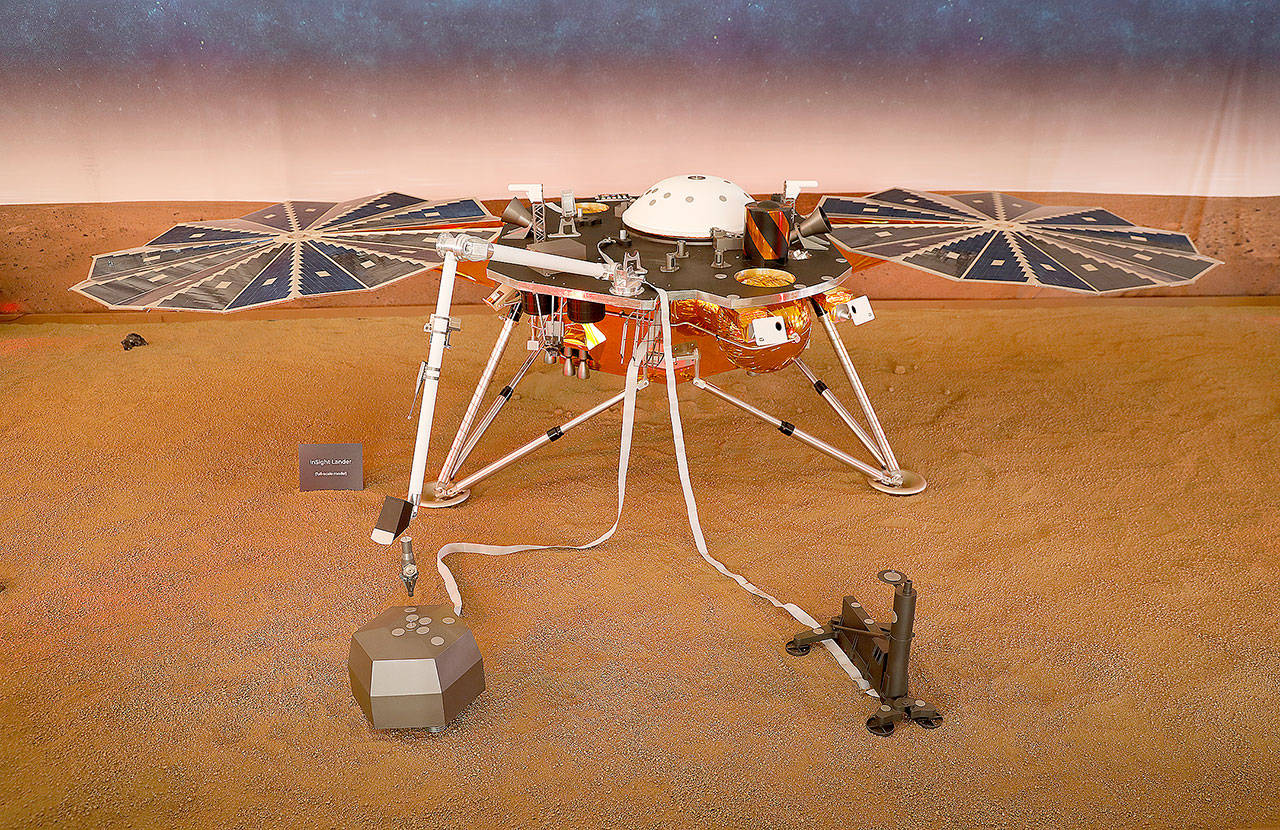By Julia Rosen
Los Angeles Times
After traveling 300 million miles through the solar system, NASA’s InSight spacecraft descended through the Martian sky Monday and touched down safely on the smooth surface of Elysium Planitia.
The news brought cheers, high-fives and fist-bumps from the scientists and engineers assembled at the Jet Propulsion Laboratory in La Canada Flintridge, Calif. It means that the two-year mission to study the inside of Mars — formally called Interior Exploration using Seismic Investigations, Geodesy and Heat Transport —is a go.
“Touchdown confirmed,” mission commentator Christine Szalai announced at 11:54 a.m. PST.
InSight launched from California’s Vandenberg Air Force Base in May and, after an uneventful seven-month cruise, closed in on Mars over Thanksgiving weekend. That meant engineers spent their holiday finessing the spacecraft’s final approach.
They checked and double-checked InSight’s trajectory, aiming it toward a 6-by-15-mile keyhole in the Martian atmosphere that would guide the vehicle toward a carefully chosen landing spot on the ruddy surface. On Sunday afternoon, they gave the spacecraft one final nudge.
Weather forecasts from NASA’s Mars Reconnaissance Orbiter showed that the outlook was sunny with a low chance of dust storms, so engineers skipped their last chance to tweak InSight’s landing procedure Monday morning. The pieces were in place; there was nothing more for Earthlings to do.
At 11:39 a.m., InSight screamed into the Martian atmosphere and, as expected, lost communication with Earth. A focused quiet fell over the crowd at JPL as everyone waited for signals confirming that InSight had made it through a series of crucial steps.
In this room, engineers have seen the delicate dance of entry, descent and landing go flawlessly — and fatally — on previous missions.
Unlike on previous missions, however, the InSight team had the benefit of two experimental satellites that tracked InSight’s progress. The Mars Cube One satellites, known as MarCOs for short, locked onto the spacecraft before it entered the Martian atmosphere and continuously relayed information back to mission control.
The signals were delayed by the eight minutes it took for radio waves to travel from Mars, meaning InSight’s fate had already been sealed by the time anyone at JPL heard about it. Still, the team members — all clad in burgundy shirts emblazoned with the InSight logo — watched with rapt attention.
First, radio telescopes in West Virginia and Germany registered a slight change in the frequency of InSight’s signal, indicating that its parachute had inflated and the craft had slowed down. A round of applause rippled through mission control; one engineer flashed a thumbs-up.
Seconds later, InSight informed the MarCOs that its radar found the ground, again prompting reserved clapping in mission control. Two engineers turned to each other and high-fived.
“This is really good news,” said Rob Manning, JPL’s chief engineer.
Finally, the MarCOs watched as InSight set down on the surface of Mars. Mission control erupted into cheers as engineers leaped to their feet, shaking hands and hugging.
“This never gets old,” Manning said.
An unexpected bonus arrived a few minutes later: The MarCOs transmitted a photo snapped by InSight of its new surroundings. Through the dust-speckled lens, it shows a smooth, flat surface with one small rock in the foreground. InSight also caught one of its legs in the shot.
On Monday evening, NASA’s Mars Odyssey orbiter is expected to confirm that InSight successfully unfurled it circular solar panels. After that, InSight will get a few weeks’ rest after its long journey.
But not the scientists and engineers working on the mission. They will have to decide exactly where and when to deploy the InSight’s instruments, and test all their commands on ForeSight, a replica of the lander housed at JPL.
“The next two months will really be the action-packed months,” said Renee Weber, a member of the InSight science team at NASA’s Marshall Space Flight Center in Huntsville, Ala.
When engineers have ironed out all the kinks, InSight will wake up. Using a robotic arm, the lander will install a super-sensitive seismometer on the Martian surface, where it will listen for meteorite impacts and Marsquakes. The seismic waves from these events will give scientists a clearer picture of the planet’s internal structure.
InSight will then deploy its heat probe, a self-hammering 16-inch nail that will burrow down as deep as 16 feet over the course of several weeks. The instrument will measure how much heat escapes from Mars’ interior, which will reveal the amount of heat-producing radioactive elements it contains and how geologically active the planet is today.
InSight’s radio signals will also be used to track the wobble of Mars’ orbit. This will help researchers understand the size and state of the Martian core.
Together, these experiments will crack open Mars and spill the planetary secrets scientists have sought for decades.
“I can’t say how satisfying it is to be within a stone’s throw of getting that information about Mars,” said JPL geophysicist Suzanne Smrekar, the deputy principal investigator for the mission.


